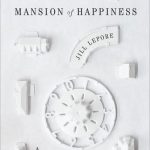Mansion of Happiness
 by Danielle Ofri
by Danielle Ofri
The San Francisco Chronicle
Review of “Mansion of happiness: A history of life and death†by Jill Lepore
Milton Bradley’s Game of Life, breast pumps, Stuart Little, Karen Ann Quinlan and eugenics would seem to have little in common. In Jill Lepore’s engaging new book, “The Mansion of Happiness,” they are the touchstones along the existential footpath of life.
“A History of Life and Death” – as the subtitle has it – could easily be a plodding, exhaustive disquisition; Lepore is a professor of history, after all. But her alter ego is as a New Yorker staff writer, and so she develops each chapter with an essayistic contour, diving in at an unexpected angle and then weaving a narrative that may perambulate historically, geographically and contextually. Yet we always come out at the other end with a thoughtful sense of how our society has grappled with these foundational concepts.
Even basic ideas – that humans arise from eggs, for example – carry extensive trails of societal debate. Great minds from Aristotle to Galen to Leonardo da Vinci weighed in for more than a century about whether humans needed one seed or two to germinate. It wasn’t until the 1650s that William Harvey – of blood circulation fame – postulated the idea of a human egg. With thematic rather than chronological logic, Lepore seamlessly links the seed-egg controversy to Lennart Nilsson’s iconic embryo photographs for Life magazine, then ends up at Stanley Kubrick’s movie “2001.”
“Baby Food,” the book’s chapter about breast-feeding, is a fascinating exploration of how sociology and politics infuse the basic facts of science at  every level. Even a scientifically neutral term such as “mammal” carries a fraught context. The taxonomist Carolus Linnaeus initially coined the category “quadrapedia” to cover this group. Well, the insinuation that humans are intrinsically animals went over as poorly with 18th century society as it does today with certain state boards of education. Linnaeus needed a more PC term. Despite the lingering overtone of sexuality (“loathsome harlotry” was one critique of the day), the idea of grouping animals by lactation eventually caught on, despite the inconvenient fact that 50 percent of mammals don’t actually lactate (or unload the dishwasher).
every level. Even a scientifically neutral term such as “mammal” carries a fraught context. The taxonomist Carolus Linnaeus initially coined the category “quadrapedia” to cover this group. Well, the insinuation that humans are intrinsically animals went over as poorly with 18th century society as it does today with certain state boards of education. Linnaeus needed a more PC term. Despite the lingering overtone of sexuality (“loathsome harlotry” was one critique of the day), the idea of grouping animals by lactation eventually caught on, despite the inconvenient fact that 50 percent of mammals don’t actually lactate (or unload the dishwasher).
And then there is the social patina that humans have layered atop biology that has recast breast-feeding from indecency to destiny to impossibility and back again, with a rapidity that would make Darwin blush. In the early 1700s, breast-feeding was only for the poor; upper-class European women wouldn’t dream of subjecting their decolletage to such animalism. By the end of that century, breast-feeding was an imperative for every woman, a veritable “act of citizenship.” In the 1800s, the pendulum swung back toward indecency.
As the 20th century dawned, American women plumb ran out of milk in the famous “epidemic of lactation failure.” A century later, those breasts somehow regained their lactational power to fuel a thriving breast-pump industry and a guilt complex for any mother who so much as fingers a can of Similac.
A fascinating theme of the book is that many life stages we take for granted were actually invented at particular times, because of a propinquity of historical events. What might be biology takes on significance only when social constructs are hammered on them.
Retirement, for example, was invented in the first decade of the 20th century when actuarial tables “proved” that productivity fell precipitously in middle age. Similarly, parenthood is an invention that straddles the germ theory, business opportunities, contraception and the politicization of abortion.
Odd bedfellows and transformations abound in this hybrid of science and socialization. When eugenics didn’t pan out, its leading America proponent turned instead to marriage counseling. Paul Popenoe, the author of “Applied Eugenics” – the standard-bearing textbook of the 1920s that was notably translated into German – became the advice dispenser for Can This Marriage Be Saved, the wildly popular column in the Ladies’ Home Journal. Who’da thunk it?
Children used to be viewed mainly in terms of labor, but then childhood was invented. Lepore’s essay “The Children’s Room” examines this through the lens of children’s literature, itself a modern invention. The heatedly divided reception of E.B. White’s “Stuart Little” marked a turning point in how society views children, their minds and their mores. “All About Erections” focuses on the invention of adolescence, as well as the lively history of the books that took up the gauntlet of explaining the squeamish aspects.
“Matters of life and death are not inherently partisan,” Lepore writes. But her chapters on contraception, abortion and the case of Karen Ann Quinlan show how starkly and how calculatingly these matters became politicized. It’s shocking to be reminded that it wasn’t always this way.
The book ends with Robert Ettinger, a nonagenarian who founded the Cryonics Institute – a warehouse full of freezers, corpses and confidence that future scientists will iron out the kinks of resurrection. Ettinger died last year, and like 105 optimists before him, was stuffed into a Walmart sleeping bag and frozen upside down.
“Trying is the human condition,” Lepore writes about our striving to understand our existence. “The Mansion of Happiness” is an important addition to the effort.
(from The San Francisco Chronicle)
